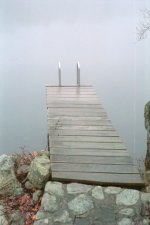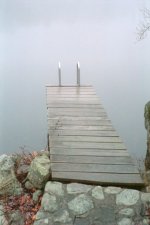Thanks Michael. My scanned images look like what you have in your posted first image, but mine have two such lines. My negative strips are already cut into short strips, and I have seven such rolls of film. It would be a time consuming task to patch up each negative strip.
Regards,
Raid
Hi Raid --
I had the same problem myself tonight. This shot is one of a roll with a nasty couple of scratches through it. I tried a few things, none of them particularly satisfactory. First I used something new to me in the GIMP (Gnu Image-Manipulation Program): the "de-stripe" filter. It seems to work by blurring the image in one direction only, perpendicular to the scratch. (There must be an analogous filter in Photoshop.) But if I used the strongest setting for de-striping I found that the picture became oddly blurred and a little posterized. So I tried "smudging" the scratch away. This seemed to darken the scratched area and the absence of grain in the smudged area was conspicuous. So I added a little noise to that area. Finally I gave up on all of that and copied a long strip of the homogenous areas of the image to the left of the scratches and pasted it over the scratch, then smudged it a bit around the edges where necessary to disguise the trick.
As you can see, nothing really worked that well, but I made some progress.
Good luck -- Michael



